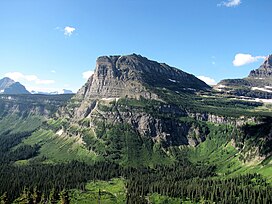| Heavy Runner Mountain | |
|---|---|
 Heavy Runner Mountain as seen from the Going-to-the-Sun Road Heavy Runner Mountain as seen from the Going-to-the-Sun Road | |
| Highest point | |
| Elevation | 8,016 ft (2,443 m) |
| Prominence | 767 ft (234 m) |
| Coordinates | 48°40′36″N 113°41′41″W / 48.67667°N 113.69472°W / 48.67667; -113.69472 |
| Geography | |
  | |
| Location | Glacier County, Montana, U.S. |
| Parent range | Lewis Range |
| Topo map | USGS Logan Pass MT |
| Climbing | |
| First ascent | Unknown |
| Easiest route | Scramble class 2-3 |
Heavy Runner Mountain (8,016 feet (2,443 m)) is located in the Lewis Range, Glacier National Park in the U.S. state of Montana. The summit is a little over a mile east-northeast of Reynolds Mountain and is easily seen from the Going-to-the-Sun Road as well as Logan Pass. The mountain is named for the Blackfeet Indian Chief, Heavy Runner, who was massacred along with most of his encampment by Col. Eugene M. Baker's detachment on the Marias River on January 23, 1870.
Climate
Based on the Köppen climate classification, Heavy Runner Mountain is located in a subarctic climate characterized by long, usually very cold winters, and short, cool to mild summers. Temperatures can drop below −10 °F with wind chill factors below −30 °F.
Geology
Like other mountains in Glacier National Park, Heavy Runner Mountain is composed of sedimentary rock laid down during the Precambrian to Jurassic periods. Formed in shallow seas, this sedimentary rock was initially uplifted beginning 170 million years ago when the Lewis Overthrust fault pushed an enormous slab of precambrian rocks 3 mi (4.8 km) thick, 50 miles (80 km) wide and 160 miles (260 km) long over younger rock of the cretaceous period.
See also
- List of mountains and mountain ranges of Glacier National Park (U.S.)
- Geology of the Rocky Mountains
References
- ^ "Heavy Runner Mountain, Montana". Peakbagger.com. Retrieved May 23, 2018.
- "Heavy Runner Mountain". Geographic Names Information System. United States Geological Survey, United States Department of the Interior. Retrieved May 23, 2018.
- Logan Pass, MT (Map). TopoQwest (United States Geological Survey Maps). Retrieved May 23, 2018.
- Through The Years In Glacier National Park An Administrative History, NPS.gov
- Peel, M. C.; Finlayson, B. L.; McMahon, T. A. (2007). "Updated world map of the Köppen−Geiger climate classification". Hydrol. Earth Syst. Sci. 11 (5): 1633–1644. Bibcode:2007HESS...11.1633P. doi:10.5194/hess-11-1633-2007. ISSN 1027-5606. S2CID 9654551.
- Gadd, Ben (2008). "Geology of the Rocky Mountains and Columbias".
{{cite journal}}: Cite journal requires|journal=(help)
Gallery
External links
- Weather forecast: Heavy Runner Mountain
This Glacier County, Montana state location article is a stub. You can help Misplaced Pages by expanding it. |

